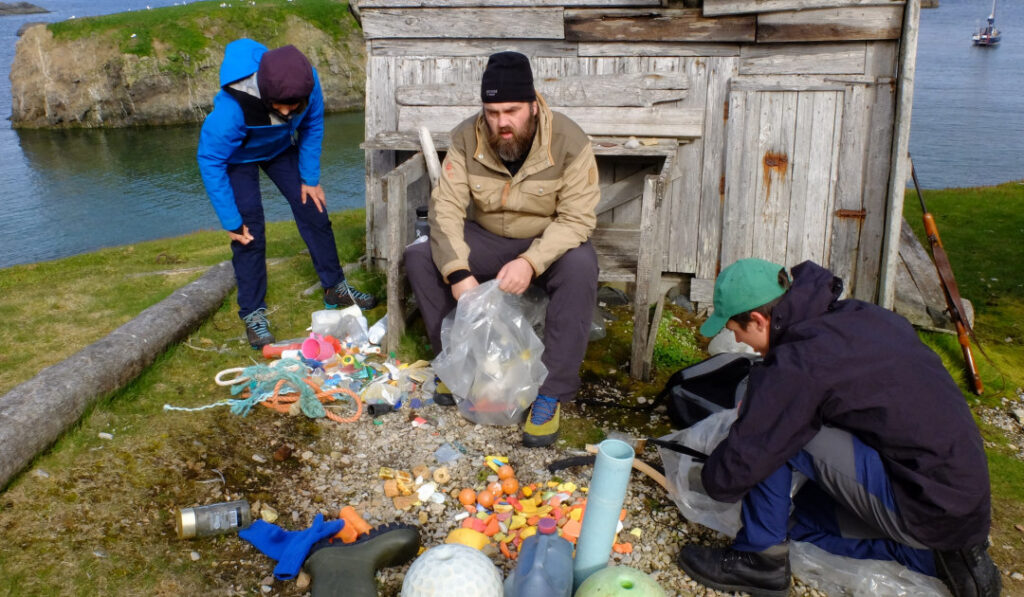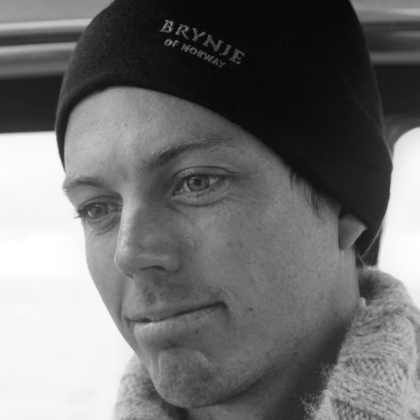
Plastic pollution is one of the greatest threats to our oceans. The small and large parts that are a symbol of our civilization do not stop at the Arctic Ocean. With the currents, the plastic waste drifts into the middle of the home of polar bears and seals. The extent of the pollution is, due to the remoteness and size of the region, only slowly becoming apparent, also thanks to private organizations and their expeditions. One such organization is “Gate to the Arctic”, which recently went to remote Bear Island to get an initial overview of the plastic situation. Their ultimate goal: An expedition with young explorers and future scientists to raise awareness for the problem among the next generation. Jon Amtrup, journalist and leader of the Norwegian Society for the Conservation of Nature was among the group of six initial explorers.
Bear Island is almost heart shaped and lies at 74 degrees North in the western part of the Barents Sea. The island is part of the Svalbard archipelago. You can definitely say that Willem Barentsz has put his mark on the polar area. The Dutch cartographer and polar explorer got the whole sea named after him. When he, and Jacob van Heemskerck, approached the little island June 10th 1596 a polar bear swam past them. They were discoverers, seized the moment and named the jagged rock Bear Island.

We sailed into our dedicated anchorage under the midnight sun, 40 hours after casting off from Tromsø. The sea had been gentle with us aboard SY Njord, our 45 foot aluminium expedition vessel, so we were well rested.
The Arctic is under pressure. Plastic is found everywhere in the Svalbard area. We found plastic on the beach in Russehamna seconds after we set foot on it. The same story can be told from most beaches around Svalbard. But it’s not only on the beaches. Plastic has been found in the deep waters between Greenland and Svalbard, and in the water and on the seabed in the Barents Sea.
According to the Norwegian Polar Institute, it is estimated to be around 194 pieces of litter per km2. The combined weight is reckoned to be 79,000 tonnes, mostly plastic.
Plastic does not magically disappear by itself. It fragments into microplastics and ends up in the ecosystem. Microplastics are pieces less than 5 mm in length. Microplastics are often used in products such as toothpaste, skin products, makeup and other cosmetics. Synthetic fabrics release huge quantities of microplastic fibres when washed, and these particles are often not captured by sewage treatment plants. They end up in the oceans.
Plastic, of all sorts, is harmful for marine life and environment, and degrades coastal areas and ecosystems in general. Plastic is slowly choking the ocean. As sailors and ocean activists we want to make a difference. That’s why we founded the non-profit Gate to the Arctic.

Gate to the Arctic is focused on making a difference in the Arctic. This year’s expedition: Clean the beaches of Bear Island for marine litter, explore and take samples for scientific use. This year´s expedition is a pilot for the 2022 edition where Gate to the Arctic will take 14-20 young explorers to the same island. The goal is to turn them into Arctic ambassadors who can inspire and teach their own generation to protect the fragile Arctic. Storytelling, e-learning and science will be key elements to reach a global audience. Gate to the Arctic will cooperate with scientists, organizations, people and companies who want to support the creation of young arctic ambassadors. “We will use sailing yachts equipped for the high latitudes as platforms, as this is more cost-efficient, environmentally friendly, flexible and brings the explorers on board closer to nature itself,” says Hans Martin Halvorsen, co-founder of Gate to the Arctic and high latitude sailor.
Staying aboard sailboats will contribute to the mindset of low consumption as one has to save water, food and fuel and have to bring waste back to the mainland.

But who is Gate to the Arctic and who was on board?

Catharina Frostad is a tech savvy ocean activist and co-founder of the successful startup Clean Seas Solution, and Gate to the Arctic. She never gets seasick and can drum up a sea shanty at any time.

Shannon Nagy, our singing marine biologist from Australia. He brought the science and special marine knowledge on board. Always smiling – even when dinner came in retour on the ocean passages.

Syver Flem, happy photographer, videomaker and storyteller. The man to send on deck in bad weather – even when seasick.

Hans Martin Halvorsen, co-founder of Gate to the Arctic and experienced high latitude sailor. Hans-Martin has sailed to Greenland, Svalbard and has special knowledge of Bear island as he was skippering a party of scientists last year and spent one month on the island.

Jon Amtrup, journalist, leader of The Norwegian Society for the Conservation of Nature (Fredrikstad and Hvaler) and co-founder of Gate to the Arctic, ocean activist, author and skipper of SY Njord.
We collected hundreds of kilos of marine debris, and could have done way more. But the time and resources were limited, and a major part of this expedition was to lay the foundation for next year’s expedition.
On the southeast side we found thousands of pieces of broken fishing buoys in all colors and shapes. On the southwest side we found the big stuff: Car tyres, fishing nets, buoys, cans and bottles in numbers. Just to mention some of it. We even found a sofa washed ashore, and we were 240 nautical miles from the nearest mainland.

We also took several water samples which also will be analyzed for microplastics by our science partner Scripps Institution of Oceanography at UC San Diego. “All our findings are public through Tableau, and every scientist can use it in their research. If we are to save the ocean we have to work together,” says Catharina Frostad.
We scanned every bit of plastic we found so we could determine what kind of plastic we had found, categorized it, and tried to find its origin if there was any text on it. All the results were sent by satellite back to Eskelund Consulting Service who punched all the data into our partner Tableau´s, a SalesForce company, software. “We had no chance of picking it all up. It was layer on layer with colorful plastic pieces in Sørhamna We have to come back with a bigger crew and more time, and we will,” says Shannon Nagy.
See www.gatetothearctic.com for more information.
Jon Amtrup







